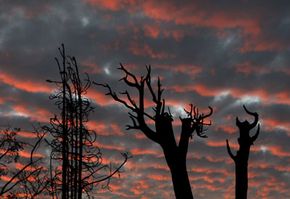The Love of Halloween
So now that we know where the different elements of Halloween come from, the question remains: Why do we revel in a celebration of death and supernatural forces?
Two related questions are:
Advertisement
- Why do we enjoy being scared?
- Why do we enjoy dressing up as scary figures?
All of these pleasures seem to be universal human traits, with death-related festivals and costume parades popping up in many cultures. As human beings, we are acutely aware of our own mortality and death in general. Human cultures are obsessed with death because we cannot understand it, yet it looms over everything we do. It is one of the most frightening mysteries we face in life. One way to feel more comfortable with this unknown realm is to make light of it with a festival. This brings all of the frightening ideas out in the open, where we can face them more comfortably, enjoying ourselves with other people instead of contemplating mortality on our own.
In addition to working through uneasiness about death and supernatural mysteries, people like to feel frightened for purely biological reasons. When you watch a scary movie or take a ride on a roller coaster, your brain triggers a fear response. Your body releases adrenaline and other hormones that provide extra energy to deal with the situation. When you're actually in danger, of course, you don't enjoy the feeling of these hormones, you simply use them to fight, escape or take some other action. When the danger is simulated, though, your mind knows you're actually safe and you enjoy the energy that the hormones give you. Intentional, contained fear is fun because it provides a hormone rush and helps you work through your general fears in a safe environment. Learn more about this reaction in How Fear Works.
By dressing up as our fears, we embrace them even more closely, taking control of them to some extent. This can be particularly effective with children. They usually don't fear mortality as much as they do sinister figures like monsters and ghosts. Once they've dressed themselves up as a monster and played that character, they cut through some of the monster's mystery, making it less ominous.
Trick-or-treating is not all about dressing up as frightening figures, of course. Just as often, children dress as a favorite cartoon character or an adult figure such as a firefighter or astronaut. The pleasure in this is the simple joy of playacting -- kids look forward to Halloween because they get to inhabit a character, whether it be a frightening figure or an idolized superhero. Adults enjoy dressing up for similar reasons, and this is why the masquerade plays a part in so many festivals from different cultures. Putting on a mask lets people drop their inhibitions and step outside of themselves for an evening. People in costumes often say and do things they probably wouldn't say or do in their everyday life. It's very satisfying to step into another character for a while, even (or especially) for a grown-up.
Halloween seems to serve a valuable function for many children and adults. It continues to be so popular because it fills our basic need to address the mysteries that frighten us and even celebrate them. It is a real testament to the power of Halloween traditions that they have been passed down and embraced by so many generations.
For more information on Halloween, other holidays and related topics, check out the links below.
Related HowStuffWorks Articles
- How to Carve a Pumpkin
- How to Throw a Halloween Party
- Costumes 101
- How often does Halloween candy tampering really happen?
- What is candy corn and how is it made?
- How Urban Legends Work
- How Nostradamus Works
- How Witchcraft Works
- How Vampires Work
- How Bats Work
- How Chupacabras Work
- How Bigfoot Works
- How Black Lights Work
- How Light Sticks Work
